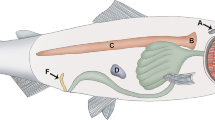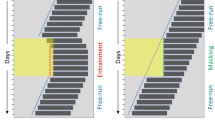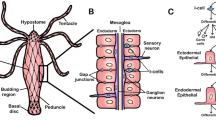Abstract
Two tyrosine hydroxylases (TH1 and TH2) are found in teleost fish, but no antibodies are available for TH2 protein to analyze the detailed structure of the system. We generated antibodies targeting TH2 and used them to characterize the TH2-producing cells in larval and adult zebrafish brain. The rabbit antisera reliably detected two bands corresponding to TH1 and TH2 close to 55 kDa in brain homogenates. The antisera detected neurons in brain nuclei which express th1 and th2 mRNA; knockdown of th2 expression by morpholino oligonucleotide injection abolished both the th2 mRNA signal and immunoreactivity with the rabbit antisera in TH2 cells. Double staining of samples with the rabbit antiserum made against TH2 and a monoclonal antibody which detects only TH1 allowed identification of cell groups expressing either one of the proteins. Cell groups in preoptic area, anterior, intermediate, and posterior part of the paraventricular organ contained neurons stained with the new TH2 antisera but not with the characterized monoclonal TH1 antibody. Neurons immunoreactive for TH2 and 5-HT were distinct. In situ hybridization for the mRNA of the immediate early gene c-fos combined with TH1/TH2 immunohistochemistry was used to characterize the cells of the zebrafish brain reacting to handling stress and a noxious chemical stimulus. Strong upregulation of c-fos expression was detected in hypothalamic nuclei containing TH2 cells, but few of the c-fos-expressing cells were positive for TH2, suggesting that these stressors do not directly activate a large proportion of TH2 cells.







Similar content being viewed by others
References
Albrecht J (1998) Roles of neuroactive amino acids in ammonia neurotoxicity. J Neurosci Res 51:133–138
Amir-Zilberstein L, Blechman J, Sztainberg Y, Norton WHJ, Reuveny A, Borodovsky N, Tahor M, Bonkowsky JL, Bally-Cuif L, Chen A, Levkowitz G (2012) Homeodomain protein otp and activity-dependent splicing modulate neuronal adaptation to stress. Neuron 73:279–291
Baraban SC, Taylor MR, Castro PA, Baier H (2005) Pentylenetetrazole induced changes in zebrafish behavior, neural activity and c-fos expression. Neuroscience 131:759–768
Burgess HA, Granato M (2007) Sensorimotor gating in larval zebrafish. J Neurosci 27:4984–4994
Candy J, Collet C (2005) Two tyrosine hydroxylase genes in teleosts. Biochim Biophys Acta 1727:35–44
Chen Y-C, Priyadarshini M, Panula P (2009) Complementary developmental expression of the two tyrosine hydroxylase transcripts in zebrafish. Histochem Cell Biol 132:375–381
Dahlbom SJ, Backström T, Lundstedt-Enkel K, Winberg S (2012) Aggression and monoamines: effects of sex and social rank in zebrafish (Danio rerio). Behav Brain Res 228:333–338
Daubner SC, Avila A, Bailey JO, Barrera D, Bermudez JY, Giles DH, Khan CA, Shaheen N, Thompson JW, Vasquez J, Oxley SP, Fitzpatrick PF (2013) Mutagenesis of a specificity-determining residue in tyrosine hydroxylase establishes that the enzyme is a robust phenylalanine hydroxylase but a fragile tyrosine hydroxylase. Biochemistry 52:1446–1455
Dunkley PR, Bobrovskaya L, Graham ME, von Nagy-Felsobuki EI, Dickson PW (2004) Tyrosine hydroxylase phosphorylation: regulation and consequences. J Neurochem 91:1025–1043
Filby AL, Paull GC, Hickmore TF, Tyler CR (2010) Unravelling the neurophysiological basis of aggression in a fish model. BMC Genom 11:498
Filippi A, Mahler J, Schweitzer J, Driever W (2010) Expression of the paralogous tyrosine hydroxylase encoding genes th1 and th2 reveals the full complement of dopaminergic and noradrenergic neurons in zebrafish larval and juvenile brain. J Comp Neurol 518:423–438
Fitzpatrick PF (2003) Mechanism of aromatic amino acid hydroxylation. Biochemistry 42:14083–14091
Gerlai R (2012) Using zebrafish to unravel the genetics of complex brain disorders. Curr Top Behav Neurosci 12:3–24. doi:10.1007/7854_2011_180
Gonçalves AF, Páscoa I, Neves JV, Coimbra J, Vijayan MM, Rodrigues P, Wilson JM (2012) The inhibitory effect of environmental ammonia on Danio rerio LPS induced acute phase response. Dev Comp Immunol 6:279–288
Herdegen T, Leah JD (1998) Inducible and constitutive transcription factors in the mammalian nervous system: control of gene expression by Jun, Fos and Krox, and CREB/ATF proteins. Brain Res Rev 28:370–490
Jiang GC, Yohrling GJ 4th, Schmitt JD, Vrana KE (2000) Identification of substrate orienting and phosphorylation sites within tryptophan hydroxylase using homology-based molecular modeling. J Mol Biol 302:1005–1017
Kaslin J (2004) The aminergic and cholinergic neurotransmitter systems in the zebrafish brain. Dissertation, University of Helsinki
Kaslin J, Panula P (2001) Comparative anatomy of the histaminergic and other aminergic systems in zebrafish (Danio rerio). J Comp Neurol 440:342–377
Lau BY, Mathur P, Gould GG, Guo S (2011) Identification of a brain center whose activity discriminates a choice behavior in zebrafish. Proc Natl Acad Sci USA 108:2581–2586
McLean DL, Fetcho JR (2004) Ontogeny and innervation patterns of dopaminergic, noradrenergic, and serotonergic neurons in larval zebrafish. J Comp Neurol 480:38–56
Mu Y, Li XQ, Zhang B, Du JL (2012) Visual input modulates audiomotor function via hypothalamic dopaminergic neurons through a cooperative mechanism. Neuron 75:688–699
Mueller T, Vernier P, Wullimann MF (2006) A phylotypic stage in vertebrate brain development: GABA cell patterns in zebrafish compared to mouse. J Comp Neurol 494:620–634
Panula P, Chen Y-C, Priyadarshini M, Kudo H, Semenova S, Sundvik M, Sallinen V (2010) The comparative neuroanatomy and neurochemistry of zebrafish CNS systems of relevance to human neuropsychiatric diseases. Neurobiol Dis 40:46–57
Pavlidis M, Sundvik M, Chen Y-C, Panula P (2011) Adaptive changes in zebrafish brain in dominant-subordinate behavioral context. Behav Brain Res 225:529–537
Priestley JV, Wotherspoon G, Savery D, Averill S, Rattray M (1990) A combined in situ hybridization and immunofluorescence procedure allowing visualisation of peptide mRNA and serotonin in single sections. J Neurosci Methods 48:99–110
Ren G, Li S, Zhong H, Lin S (2013) Zebrafish tyrosine hydroxylase 2 gene encodes tryptophan hydroxylase. J Biol Chem 288:22451–22459
Rink E, Wullimann MF (2002) Development of the catecholaminergic system in the early zebrafish brain: an immunohistochemical study. Brain Res Dev Brain Res 137:89–100
Sallinen V, Torkko V, Sundvik M, Reenilä I, Khrustalyov D, Kaslin J, Panula P (2009) MPTP and MPP+ target specific aminergic cell populations in larval zebrafish. J Neurochem 108:719–731
Schweitzer J, Driever W (2009) Development of the dopamine systems in zebrafish. Adv Exp Med Biol 651:1–14
Steele SL, Ekker M, Perry SF (2011) Interactive effects of development and hypoxia on catecholamine synthesis and cardiac function in zebrafish (Danio rerio). J Comp Physiol B 181:527–538
Sundvik M, Kudo H, Toivonen P, Rozov S, Chen Y-C, Panula P (2011) The histaminergic system regulates wakefulness and orexin/hypocretin neuron development via histamine receptor H1 in zebrafish. FASEB J 25:4338–4347
Teles MC, Dahlbom SJ, Winberg S, Oliveira RF (2013) Social modulation of brain monoamine levels in zebrafish. Behav Brain Res 253:17–24. doi:10.1016/j.bbr.2013.07.012
Yamamoto K, Ruuskanen JO, Wullimann MF, Vernier P (2010) Two tyrosine hydroxylase genes in vertebrates. New dopaminergic territories revealed in the zebrafish brain. Mol Cell Neurosci 43:394–402
Yamamoto K, Ruuskanen JO, Wullimann MF, Vernier P (2011) Differential expression of dopaminergic cell markers in the adult zebrafish forebrain. J Comp Neurol 519:576–598
Acknowledgments
This work was supported by the Academy of Finland, Sigrid Juselius Foundation, CIMO (Center for International Mobility), and Finska Läkaresällskapet. We thank Reeta Huhtala, MSc, and Henri Koivula, BSc, for expert technical help.
Author information
Authors and Affiliations
Corresponding author
Electronic supplementary material
Below is the link to the electronic supplementary material.
Rights and permissions
About this article
Cite this article
Semenova, S.A., Chen, YC., Zhao, X. et al. The tyrosine hydroxylase 2 (TH2) system in zebrafish brain and stress activation of hypothalamic cells. Histochem Cell Biol 142, 619–633 (2014). https://doi.org/10.1007/s00418-014-1240-z
Accepted:
Published:
Issue Date:
DOI: https://doi.org/10.1007/s00418-014-1240-z




